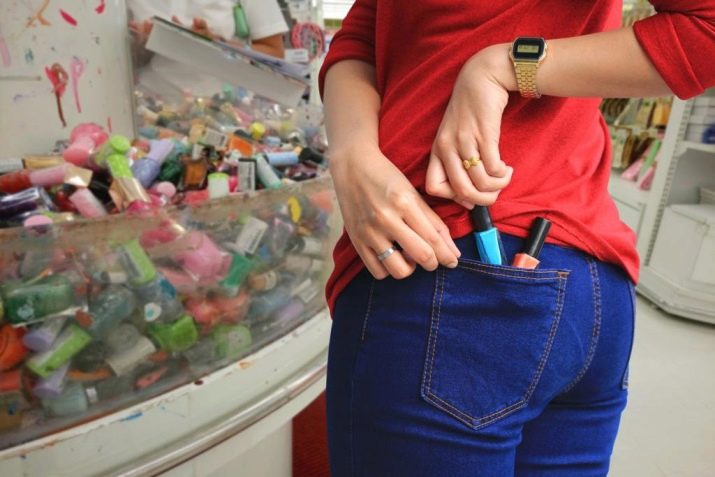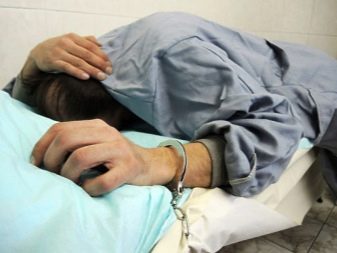Recently, the names of many psychiatric ailments are included in our usual vocabulary and remain there. This happened with "kleptomania" - a pathological craving for theft. Today, any recidivist thief is called a kleptomaniac, and this fact cannot but surprise, because true kleptomania is a rather rare mental illness.

Description
Is kleptomania not a bad habit and not a challenge to society, not a strange fun, namely a mental illness, the name of which comes from the ancient Greek words κλ? πτειν - “steal”, “theft” and μαν? α - “pathological attraction”. The disease really exists, it is listed in the ICD-10 under the code F63.2. This type of disorder is often also called theft mania. The first that the disease was guessed by French doctors, and this happened in 1816. And until the last century, their version was basic: doctors around the world recognized kleptomania as a painful craving to steal something as a manifestation of hysteria, dementia, brain damage or menstrual irregularities in women (and the greatest scientists of the world considered this relationship seriously and even found it its reasonable!).
Modern doctors look at kleptomania as a manic state that occurs in violation of self-control. This means that the kleptomaniac can not resist the obsessive desire to steal. There is also a scientific hypothesis that completely denies the presence of such a disease.Those who deny kleptomania in principle argue that the disease was “invented” by humanity in order to justify the most ordinary ordinary theft (patients can be avoided in prison).

Official medicine today has a different opinion. Kleptomania is a drive disorder. Often it is accompanied by other mental ailments, for example, anxiety disorder, eating disorders, alcoholism. Kleptomaniacs are impulsive, they do not pursue any personal or other benefits by their actions (in favor of this is the fact that more often than not they steal things that they don’t even know where to use, unnecessary to them). Theft is committed in order to simply enjoy the release of adrenaline (after all, the process of theft is closely associated with a strong release of stress hormones).
To say how many kleptomaniacs live on the planet, there is not a single opportunity. Diagnosis of the disease is very difficult, patients do not go to the doctors, for fear of losing their social status and reputation. In Russia, psychiatrists see patients with such a diagnosis in isolated cases, in the USA - more often due to a different mentality. And American psychiatrists from the National Association claim that up to 7% of the country's inhabitants are latent or open kleptomaniacs. Their Canadian counterparts supplemented the data with a picture of an average portrait of a classic kleptomaniac: this is a woman aged 30 to 40 years. It is believed that kleptomania is not inherited, but this has not yet been proven.


Kleptomania, according to psychologists, can affect not only people. In England, lives the world famous Tommy cat, which, for unknown reasons, steals shoes from neighbors and brings it to his home. Fame came to the four-legged after the owners counted in the cat's cache about 50 pairs of good, high-quality foreign shoes.
In history, as the most royal kleptomaniac, the French monarch Heinrich of Navarre will forever remain. The richest man of his time could not resist the temptation to steal some trinket away. Realizing that he was not acting royally, then Henry always sent a messenger with a trinket back to the owners every time. Henry tried to make fun of his subordinates, explaining that he was so easily able to circle them around his finger.
American writer Neil Cassidy (one of the founders of the beat generation) suffered from kleptomania all his life, but it was "narrow profile": the writer stole only cars. From 14 to 20 years, he was able to steal about 500 cars. Kleptomania was not the only problem of the writer, he had signs of various mental disorders, and he tried to ease his obsessive thoughts with drugs, psychoactive substances and an unbridled lifestyle.


Kleptomaniac is Hollywood actress Lindsay Lohan, she was even sentenced for shoplifting. But even after working out the correctional hours laid down by the sentence, Lindsay was repeatedly noticed in petty and large theft. The same diagnosis was established along with oniomania (shopaholism), addiction and depression to singer Britney Spears. She stole only lighters and wigs from intimate stores.
Winona Ryder, another Hollywood diva, was officially recognized by kleptomaniac doctors about 10 years ago. She steals clothing from stores, for which she was already punished by the police. But all in vain. Winona got into criminal chronicles later.


Causes of occurrence
Like most manic attraction disorders, kleptomania has very mysterious causes. Scientists and psychiatrists are still arguing about them. Nevertheless, it has been established very precisely that in the vast majority of cases, kleptomania goes hand in hand with other mental disorders, that is, it occurs in systemic combinations. It is believed that a painful craving for theft is manifested as a result of existing psychopathy or schizophrenia. Kleptomania differs from other mania by some characteristic features:
- kleptomaniacs more often than other patients suffer from eating disorders, nutrition;
- people with clinical kleptomania have a high tendency to depression;
- such patients, as a rule, have one or more phobias (pathological irrational fears).

Quite often, the occurrence of kleptomania, according to doctors, is influenced by bad habits, especially alcoholism and drug addiction, as well as gambling addiction. Kleptomania can remain latent for a long time. And the debut usually occurs in situations in which a person has experienced prolonged stress. Psychiatrists tend to see this as a kind of subconscious desire to feel sorry for themselves, as they did in childhood: to reward themselves for suffering and hardship.
Kleptomania should not include cases of kleptoalgia - a mental disorder in which, with the help of theft, a person tries to compensate for sexual dissatisfaction.
There are several hypotheses that can explain the causes of kleptomania and other manic states. In particular, it is believed that a disturbance in the balance of neurotransmitters (a small amount of serotonin produced, a high level of dopamine) can act as provoking factors. Wherein a person has a biological unconscious need for increased doses of adrenaline: committing theft is associated with anxiety and risk, and this gives him the opportunity to get adrenaline. Having committed the theft, a person experiences satisfaction, euphoria, but then realizes the perfect, and he is tormented by a sense of shame. Gradually, theft becomes a conditioned-reflex connection, which allows you to enjoy, inaccessible in any other situations.


Symptoms and Diagnosis
Psychiatrists emit a triad of symptoms which are necessarily present in the true kleptomaniac:
- compulsion - the need to commit theft, which is guided by a previous obsession about committing theft;
- receiving great pleasure during the commission of a crime and after it for some time;
- a strong feeling of guilt after the deed after some time, which plunges a person into an anxious and near depression state.
And then everything - in cycles. Depression and guilt cause a lack of serotonin, an increased level of dopamine, there is a strong need to increase adrenaline, but this can only be done in one way: go and steal something again. At this stage, a person who has recently given himself the word to never do this again loses the opportunity to enjoy in any other way: neither sex, nor tasty food, nor other joys of life give him the right amount of adrenaline. There is an obsession with theft. A person becomes anxious, restless, nervous. He is not happy with anything, he can start using alcohol and drugs already because at least temporarily at first it gives the illusion of liberation from a painful attraction.
Reaching the highest point of tension, a person goes and commits theft. He never plans it, doesn’t think out the ways of withdrawal, the sales channels of the stolen goods - this does not interest him. He commits theft impulsively. And immediately the heavy oppressive tension is replaced by the same great and joyful relief. The mood rises, the person is happy, he is really good.

As soon as the adrenaline level begins to decline (and this usually happens within 1-2 days), a feeling of guilt appears, sleep, appetite is disturbed, and everything starts all over again. Under the influence of the impulse that pushes the kleptomaniac to theft, he can commit theft almost anywhere: in a huge shopping center or in a small convenience store, with relatives, friends or in the workplace.The most unusual cases of kleptomania described in medical literature include a fact that ended up in the Guinness Book of Records: a man stole a steamboat, picking up at the pier and cutting down the mounts.
It is noteworthy that a kleptomaniac can safely be entrusted with work related to liability for material assets (money, expensive equipment), because usually they do not take anything from the area of responsibility, but pens, cups and other trifles will regularly disappear at work. There is a known case when the head coach of a football team, having access to both the club’s money and material assets, stole from the office of a sports doctor just a centrifuge for blood tests. When asked by the police why he needed it, the kleptomaniac coach was never able to give an intelligible answer. Later, psychiatrists recognized him as insane.

In the guilt stage, many kleptomaniacs can return the stolen themselves, toss it back in secret. Either they give the stolen item to someone or throw it away. It is important for them to get rid of the stolen at any cost, because the thing is a reminder of the socially unacceptable act that they committed.
The periods between cycles are gradually reduced, and episodes of theft become more frequent. With a persistent disorder that has existed for several years, a person begins to have complications: the anxiety associated with a possible rapid collapse of his reputation increases. Most of the time he is in a bad mood, depressed. He sets boundaries and tries to isolate himself from society.
The likelihood of drinking or becoming an addict increases, often suicidal impulses and ideas appear. But psychological consequences are not the only thing a kleptomaniac can expect. Obtaining a criminal record, financial difficulties due to the need to pay compensation by court decision are not ruled out.
If the lack of intent is proved, that is, the person is recognized as ill, he will escape the prison, but will be placed on compulsory psychiatric treatment. His life will be ruined.


To diagnose the disease, use the list of signs described by the “Diagnostic and Statistical Manual of Mental Disorders”. It means that a person must show certain symptoms.
- Inability to overcome a painful addiction for several episodes.
- The lack of benefits for the violator, and the objects stolen by him should not be of benefit or value to him.
- Theft is fun and has nothing to do with revenge, hallucinations or delirium. And also in a person should not show asocial mania, organic brain damage and bipolar disorder (theft to kleptomania are not related).
Diagnosis is carried out by specialist psychiatrists, and the diagnosis is made by a special commission. The task of the experts of this commission is not only to assess signs and symptoms, but also to identify possible simulations (sometimes it is much easier for a recidivist thief to go to a hospital for treatment than to a prison for a long time, and therefore criminals often try to pass themselves off as kleptomaniacs). There is a whole system of tests that allow you to establish the true motives, the reasons for the theft.
If necessary, hypnotic psychotherapists work with the patient. If organic CNS lesions are suspected, an MRI or CT scan is done.

How to distinguish a kleptomaniac from a thief?
With the naked eye and without the basics of knowing the forms of deviant behavior, it is quite difficult to distinguish an ordinary thief from a kleptomaniac. The main thing is the difference - the motive. Kleptomaniac is a sick person for whom there is no benefit in theft. A thief commits a crime knowingly, of his own free will or under the influence of certain life circumstances, he has the benefit of committing theft. The differences are actually more extensive.
- Planning theft details. Kleptomaniac, in addition to the lack of benefits, never thinks in advance where, when and how the theft should take place. He obeys the impulse "saw - liked - took." The thief thinks over the details, studies the store’s plan, knows the time of his work, the location of the surveillance cameras. He pre-watches what he needs and thinks out ways to commit a crime and endure stolen goods.
- The fate of the stolen. The kleptomaniac tries to throw away or give away the stolen goods, the thief tries to sell it or exchange it for something valuable (again, we return to the question of material gain).
- Behavior during police detention. Kleptomaniacs are embarrassed by their illness, and many of them would rather go to jail than to let everyone around them know that they have a mental illness. The thief will seek profit here: he will declare himself a kleptomaniac voluntarily in the hope of avoiding prison sentences and will carefully simulate the disease.
In Russian practice, it’s quite difficult to recognize even a real kleptomaniac patient. The thing is that the packaging of office paper clips has its own value, and convincing the judges that for a person with high incomes this bundle of paper clips does not represent any benefit - the task is almost unrealistic. In the USA and European courts, the approach is different: they rely on the fact of marketing. There was a sale, which means that a person is a thief, there was no sale (even if you have not managed to sell it yet), which means that you are a kleptomaniac.
Especially if the defendant himself claims that the 50 radio tape recorders that he stole "purely from the thirst to steal", in fact, he did not need at all. Just "could not resist."

It is difficult to compose a social portrait of a thief: thieves are different. But for kleptomaniacs, according to psychiatrists, some common features are characteristic:
- usually they are quite wealthy people who can definitely afford to buy what they stole without harming the wallet;
- mainly the disease is characteristic of women;
- kleptomaniacs are sincerely ashamed of what they have done;
- in everyday life, kleptomaniacs are usually quite law-abiding citizens.
Thus, a man sitting in front of you with tattoos, without a certain type of activity and two criminal records behind him, claiming to have specially chosen this store, grabbed gloves, left the car at the entrance and took some gold items due to kleptomania - this is a simulator. A frightened and embarrassed man who was caught in a petty and ridiculous shoplifting (he took toothpicks, a stand for a glass), claiming that he had stumbled and was ready to be punished, could very well turn out to be a kleptomaniac. But he himself will never want to admit that he has a pathological bad habit, a disease — it's better to go to jail.

How to treat?
Before planning treatment, you need to lure the kleptomaniac to a psychiatrist. And this is not an easy task. Shyness and a feeling of sincere remorse, which are becoming familiar to the kleptomaniac, prevent him from honestly confessing to the specialist his attraction, telling his feelings and emotions. But independent attempts to correct the situation, change usually have no effect, each time ending in a new attack and a new theft.
Therefore, usually the disease becomes known in the framework of the examination prescribed by the court, when the patient has already been caught in a series of thefts. Quite rarely, relatives of kleptomaniacs turn to doctors, who, at the cost of incredible efforts, persuade patients to still visit a specialist. Such cases are rare.
Kleptomania in adults is treated, like many other attraction disorders, in a complex: drug therapy is combined with psychotherapeutic correction programs. Of drugs, antidepressant drugs are usually preferred. They help increase the serotonin content in the body, due to which the irrepressible need for adrenaline surges begins to decrease.
Much depends on the concomitant mental disorder: with some of them you can do only antidepressants, while others require the appointment of tranquilizers, antipsychotics. If a person has alcoholism or drug addiction, treatment begins with them.

The most effective method is considered to be psychotherapy. A long-term or short-term program can be chosen - it depends on the type and severity of the disorder. The doctor’s task is to identify negative experiences that could become fundamental to kleptomania. Then begins the change of attitudes to the correct ones, behavioral therapy makes it possible to form new reactions to old traumatic situations. Group sessions with a therapist have proven pretty good.
Forecasts regarding kleptomania, unfortunately, are not the most favorable. This disorder (like other impairment of attraction) is very difficult to correct. If a person has no motivation to get rid of addiction, to fight, then the result will not be achieved either by psychotherapy or drugs - the desire to steal will return.

Kleptomania in children and adolescents
In children of preschool and school age, kleptomania can occur at any time, and it will have its own specific causes and symptoms. Most often, systematic child petty theft is a definite signal that an insurmountable problem has arisen in the emotional and psychological state of the child. It is by theft that he is trying to attract public attention to her. There are problems that may cause a desire to steal.
- Competition for parental attention (a brother or sister was born in the family, the child began to receive less attention from mom and dad).
- Communicative trouble. There are problems with communication in a team of peers. Committing theft, the child shows his peers that he is brave, strong, smart, and therefore it may well be not only a full member of the company, but also its leader.
- Curiosity. The child commits impulsive, spontaneous theft simply because the subject seemed very interesting to him, attracted his attention.
After the theft, the child will be excited, excited. He will begin to appear small other people's things.












